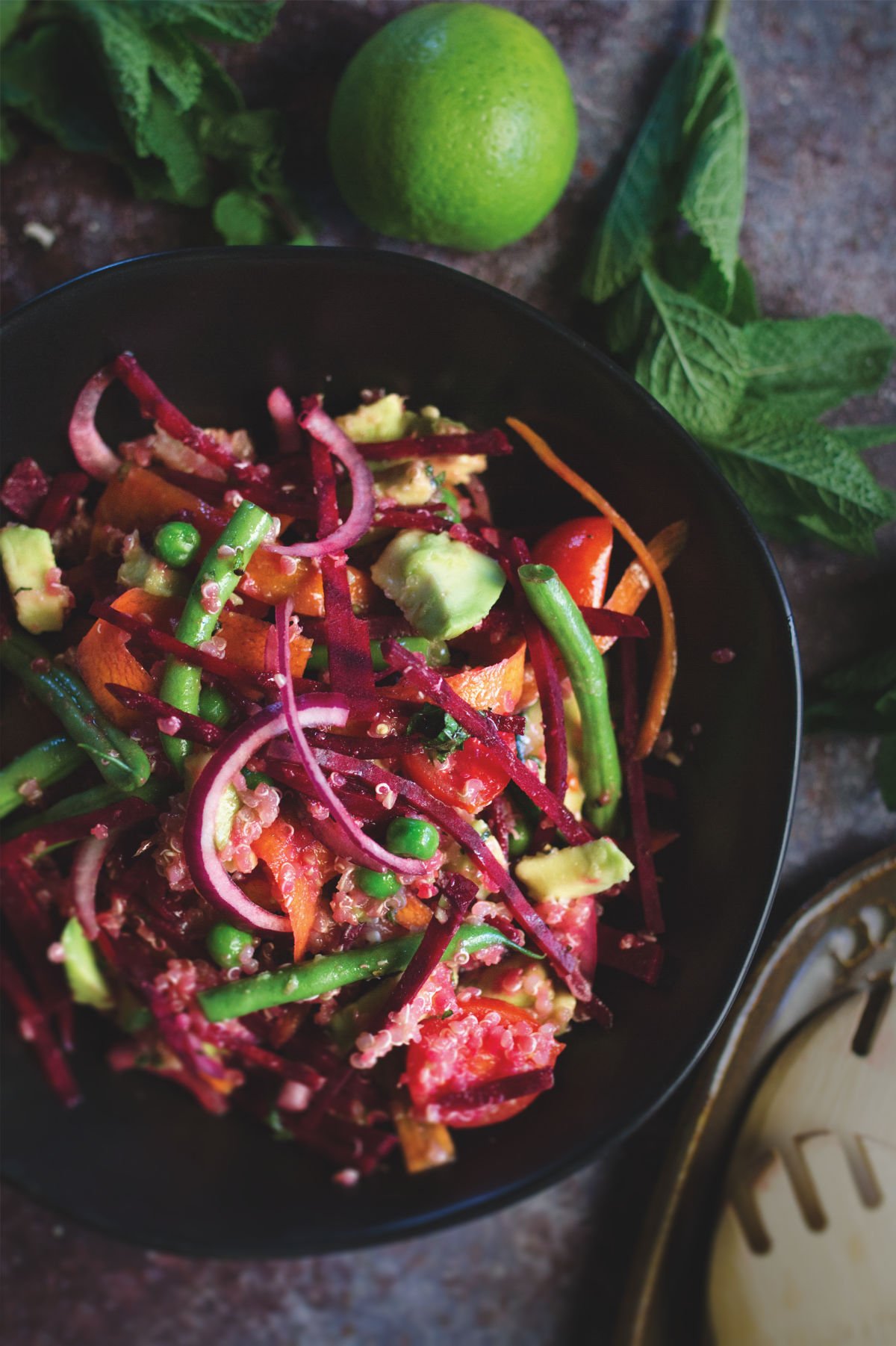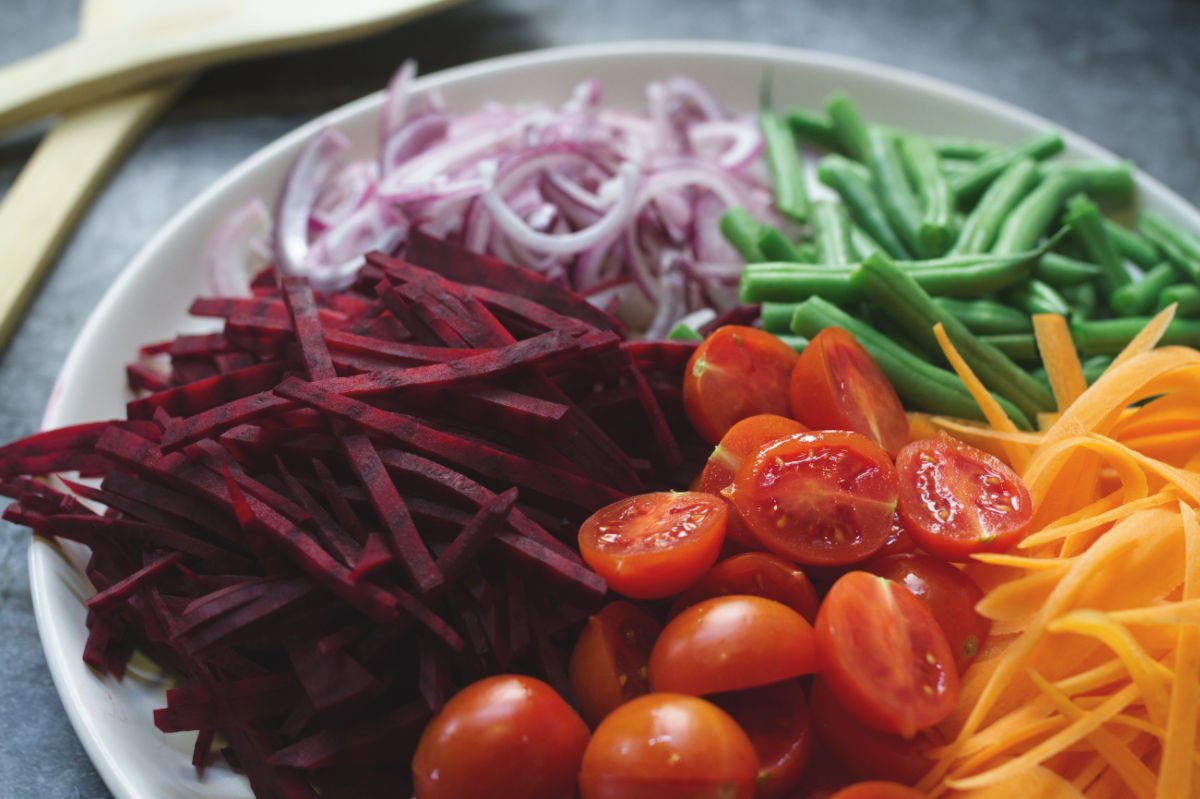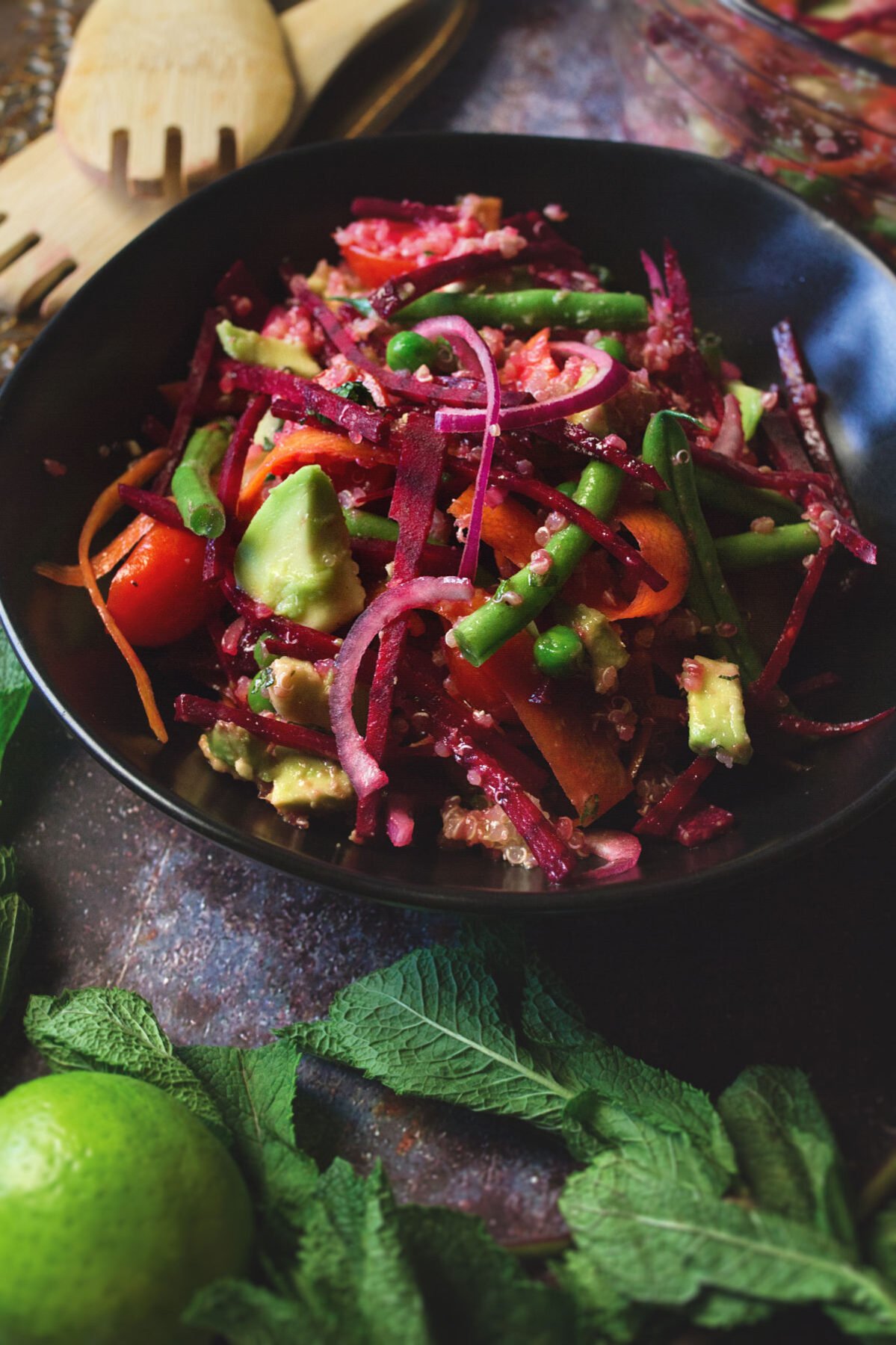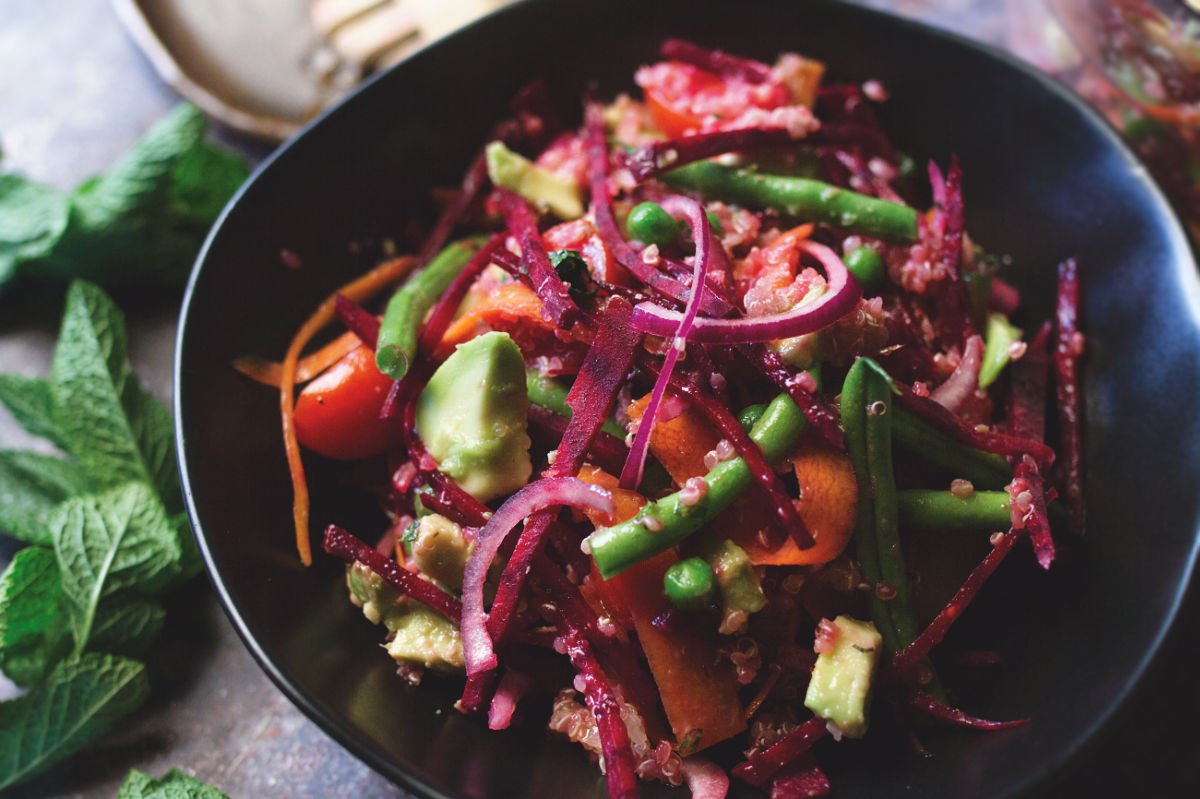Vegan | Healthy Salad Recipe / Easy to Prepare
Beet and quinoa salad with a lime and mustard dressing is a refreshing and vibrant salad ideal for those warm summer nights. Vegan-friendly and loaded with healthy ingredients, this salad gets plenty of color from the rich raw beets, crunchy green beans, and crisp red onion. Taking the flavors up a notch is the refreshing mint and avocado, mixed with soft fluffy quinoa that’s cooked to perfection and drizzled with a delicious lime and mustard dressing.
We first tried this at a friend’s place for lunch and she got the recipe from Cookie + Cake. I love a delicious, healthy, and filling salad so had to share this. I adapted it slightly but the dressing is incredible so I recommend sticking to the quantities as close as possible.
Table of contents:
What is Hummus?
Origin of Beet and Quinoa Salad Ingredients
While Quinoa is native to the Andean region of South America, the use of quinoa in Mediterranean cuisine has become something of a buzz in recent years. This is likely due to the fact that quinoa is just so good for you and tops the charts for foods with complex carbohydrates, giving the humble seed a firm stance amongst other ingredients found in the Mediterranean diet.
Beets (Beetroots for our British and Antipodean friends) are native to the Mediterranean region and were initially prized for their edible roots and leaves. They have also been praised for their medicinal qualities for thousands of years. Beets contain various antioxidants, including betalains, which are responsible for their vibrant red color. No wonder they’ve ended up on our plate and are nowadays a feature for many recipes!
Why You’ll Love This Recipe
- Every color of the rainbow- the kids will love it!
- Vegan-friendly
- Loaded with healthy and fresh Mediterranean ingredients
- High fiber, high protein
- The tangy lime and mustard dressing!

How to Make Beet and Quinoa Salad
Ingredients
For the Salad
- ½ cup quinoa, rinsed
- 1 cup green peas (we used frozen peas)
- 1 raw beet, peeled
- 1 large carrot, peeled
- 1 English cucumber, cut into half-moons
- 1 cup cherry tomatoes
- 1 small red onion, finely sliced
- Handful of green beans
- 1 avocado, cubed
- Fresh mint (or parsley)
For the lime and mustard dressing
- 3 tablespoons olive oil
- Juice from 1 lime
- 1 teaspoon apple cider vinegar
- 1 tablespoon chopped fresh mint
- 2 tablespoons Maple Syrup
- 1 teaspoon Dijon mustard
- Salt and pepper (to taste)

Equipment
- 1 large bowl
- Box Grater
- Salad spoons or tongs
- Lemon squeezer (optional)
- Small bowl, for serving
- Kitchen knife and cutting board
Instructions
Step 1 – Prepare quinoa
- Rinse the Quinoa: Before cooking, rinse quinoa thoroughly under cold water using a fine-mesh strainer. This removes any bitter-tasting saponins that coat the seeds.
- Water to Quinoa Ratio: The general ratio for cooking quinoa is 2 parts water to 1 part quinoa. For example, if you’re cooking 1 cup of quinoa, you’ll need 2 cups of water.
- Boil the Water: In a saucepan, bring the water to a boil.
- Add Quinoa: Once the water is boiling, add the rinsed quinoa to the saucepan.
- Simmer: Reduce the heat to low, cover the saucepan with a lid, and let the quinoa simmer for about 15-20 minutes, or until all the water is absorbed and the quinoa is tender. You’ll know it’s done when the grains become translucent and the germ ring appears.
- Fluff with a Fork: Once cooked, remove the saucepan from the heat and let it sit, covered, for a few minutes. Then, fluff the quinoa with a fork to separate the grains. Set aside to cool and for use later.
Step 2 – Prepare salad veggies
- Peel the skin from the carrot, then use the peeler to peel small strips. Alternatively, use a sharp kitchen knife to cut fine slices.
- Remove the stalks from the beans and cut them into bite-sized pieces.
- Cut your cucumber down the middle lengthways, then into small half moons around 0.5cm (¼ inch) thick.
- Halve the cherry tomatoes and finely slice the red onion (the finer the better).
- Peel and finely slice the raw beet (see detailed instructions in the article body).
- Right before serving, halve the avocado, remove the seed, and slice it into small pieces.
Step 3 – Arrange salad
- To a large mixing bowl, add half the salad ingredients (except the avocado) and around half of the cooled quinoa. Mix well. Then add the remaining quinoa and salad ingredients and mix well again.
Step 4 – Prepare the lime and mustard dressing
- Add all the dressing ingredients to a small bowl and whisk well for around 1 minute.
Step 5 – Dress Salad and Serve
- Season to taste and drizzle dressing over the salad.
- Toss the salad and add the avocado chunks and plenty of freshly chopped mint.
Cooking tips:
- You can use a spiralizer to cut your carrot, beet, and other veg into thin slices.
- Cooked beets can be used as a substitute for raw beets. More info about the nutrition differences between the two can be found below in the main article.
- The lime and mustard dressing can be made in a jar with a sealable lid, allowing for handy storage of any leftover dressing.

How to Prepare Raw Beets
Preparing raw beets is fairly straightforward, though they can be a bit messy due to their vibrant color. Be careful with the beet juice as it will stain clothes and benchtops if left to soak in (I have a handy tip on how to easily remove the beet juice stains from your hands at the bottom of this section).
Here’s a simple guide to preparing raw beets:
- Choose Fresh Beets: Look for beets that are firm, smooth, and have a vibrant color. Avoid beets that are soft, wrinkled, or have cuts or blemishes.
- Wash Thoroughly: Start by rinsing the beets under cold water to remove any dirt or debris. If they’re really grubby and caked with dirt, use a vegetable brush to scrub the skin gently.
- Peel: While the skin of beets is edible (although somewhat bitter), some people prefer to peel them. Use a vegetable peeler to remove the skin.
Slice or Grate: Once washed and peeled, thinly slice the beets with a sharp knife or use a box grater to grate them.
Can I use canned beets instead?
Sure. Canned beets are pre-cooked and ready to eat straight out of the can. Canned beets are usually preserved in a watery brine and have a softer texture due to the canning process. While canned beets still contain some nutrients, the canning process can lead to a loss of certain vitamins and minerals, particularly water-soluble vitamins C and B.
How to remove beet juice stains from your hands
Beet juice stains can be quite stubborn, but there are several methods you can try to remove them from your hands. Here are two proven methods to remove beet stains from your skin and hands.
- Salt: Rub coarse salt over your hands and between your fingers. Do this for a minute or two. Then use some warm soapy water to rinse off the salt and the beet stains will disappear.
Baking Soda Paste: Make a paste by mixing baking soda with a small amount of water. Apply the paste to the stained areas of your hands and gently rub in a circular motion. Rinse your hands with warm water and soap.

How healthy are beets?
Like the saying goes, you can’t beat a beet! Beets are highly nutritious and offer a range of health benefits, making them a valuable addition to a balanced diet. Not a short list; below are just a few reasons why beets are so good for you:
- Nutrient-Rich: Beets are packed with essential vitamins and minerals, including folate (vitamin B9), manganese, potassium, vitamin C, iron, magnesium, and vitamin B6. These nutrients play various roles in supporting overall health, including immune function, energy production, and blood cell formation.
- Antioxidant Properties: Beets contain potent antioxidants, such as betalains and other phenolic compounds, which help protect cells from damage caused by harmful molecules called free radicals. Antioxidants are associated with a reduced risk of chronic diseases, including heart disease, cancer, and inflammation.
- Heart Health: The nitrates found in beets can be converted into nitric oxide in the body, which helps dilate blood vessels and improve blood flow. Consuming nitrate-rich foods like beets may help lower blood pressure, improve cardiovascular function, and reduce the risk of heart disease.
- Digestive Health: Beets are a good source of dietary fiber, which is essential for digestive health. Fiber helps promote regular bowel movements, prevent constipation, and support the growth of beneficial gut bacteria. Adequate fiber intake is also associated with a reduced risk of digestive disorders, such as diverticulitis and colon cancer.
- Weight Management: Beets are relatively low in calories and contain no fat, making them a nutritious and filling option for those looking to manage their weight. The fiber content in beets helps promote feelings of fullness and satiety, which can aid in weight loss or weight maintenance.
- Exercise Performance: Some studies suggest that consuming beet juice or beetroot supplements may enhance exercise performance and endurance, thanks to their nitrate content. Nitric oxide helps improve blood flow to muscles, potentially increasing oxygen delivery and reducing fatigue during exercise.
- Brain Health: The nitrates in beets may also have benefits for brain health by increasing blood flow to the brain. Improved blood flow and oxygen delivery to brain cells may help enhance cognitive function, memory, and overall brain health.
Anti-Inflammatory Effects: Some compounds found in beets have anti-inflammatory properties, which may help reduce inflammation and oxidative stress in the body. Chronic inflammation is linked to various diseases, including heart disease, diabetes, and arthritis.
Quinoa: What is it and how to cook it
Quinoa (pronounced Keen-wah) is a highly nutritious pseudo-cereal that has gained popularity in recent years due to its health benefits and versatility in cooking. While it is technically a seed, it’s commonly referred to as a grain due to its similar taste and cooking properties. Quinoa is considered a complex carbohydrate, which helps maintain its natural fiber and fuel your body with the energy it needs.
How to Cook Quinoa
Cooking quinoa is quite simple and similar to cooking rice. Here’s a basic method:
- Rinse the Quinoa: Before cooking, it’s recommended to rinse quinoa thoroughly under cold water using a fine-mesh strainer. This removes any bitter-tasting saponins that coat the seeds.
- Water to Quinoa Ratio: The general ratio for cooking quinoa is 2 parts water to 1 part quinoa. For example, if you’re cooking 1 cup of quinoa, you’ll need 2 cups of water.
- Boil the Water: In a saucepan, bring the water to a boil.
- Add Quinoa: Once the water is boiling, add the rinsed quinoa to the saucepan.
- Simmer: Reduce the heat to low, cover the saucepan with a lid, and let the quinoa simmer for about 15-20 minutes, or until all the water is absorbed and the quinoa is tender. You’ll know it’s done when the grains become translucent and the germ ring appears.
- Fluff with a Fork: Once cooked, remove the saucepan from the heat and let it sit, covered, for a few minutes. Then, fluff the quinoa with a fork to separate the grains.
Serve: Quinoa can be served as a side dish, mixed with vegetables, added to salads, soups, or used as a base for bowls.

Ingredient substitutions
The beauty of any salad recipe is that pretty much any ingredient can be subbed out or in to suit your dietary preference or personal taste. Here are a few suggestions to boost your beet and quinoa salad to the next level:
Double up: Go double on the carrot and beet and you’ll have a lusciously textured and colorful salad that’s sure to impress.
Give it a protein hit: Toss in some roasted tofu or chickpeas to give this salad a bit of extra protein and want a more filling main meal. For a non-vegan protein boost, grilled chicken breast or turkey will add some extra bulk to this vibrant and healthy salad.
Extra herbs please: There’s loads of delicious fresh mint in this salad, but there’s plenty of opportunity to change it up with cilantro, parsley, or even fresh basil.
Nutrition Facts
| Serving size: 250g | |
| Servings: 4 | |
| Amount per serving | |
| Calories | 276 |
| % Daily Value* | |
| Total Fat 16.2g | 21% |
| Saturated Fat 2.7g | 13% |
| Cholesterol 0mg | 0% |
| Sodium 96mg | 4% |
| Total Carbohydrate 31.6g | 11% |
| Dietary Fiber 7.3g | 26% |
| Total Sugars 15.2g | |
| Protein 5.6g | |
| Vitamin D 0mcg | 0% |
| Calcium 69mg | 5% |
| Iron 2mg | 11% |
| Potassium 680mg | 14% |
| *The % Daily Value (DV) tells you how much a nutrient in a food serving contributes to a daily diet. 2,000 calories a day is used for general nutrition advice. | |

Beet and Quinoa Salad
Equipment
- 1 Large bowl
- Box Grater
- Salad spoons or tongs
- Lemon squeezer (optional)
- Small bowl, for serving
- Kitchen knife and cutting board
Ingredients
For the Salad
- ½ cup quinoa rinsed
- 1 cup green peas we used frozen peas
- 1 raw beet peeled
- 1 large carrot peeled
- 1 English cucumber cut into half-moons
- 1 cup cherry tomatoes
- 1 small red onion finely sliced
- Handful of green beans
- 1 avocado cubed
- Fresh mint or parsley
For the lime and mustard dressing
- 3 tablespoons olive oil
- Juice from 1 lime
- 1 teaspoon apple cider vinegar
- 1 tablespoon chopped fresh mint
- 2 tablespoons Maple Syrup
- 1 teaspoon Dijon mustard
- Salt and pepper to taste
Instructions
Step 1 – Prepare quinoa
- Rinse the Quinoa: Before cooking, rinse quinoa thoroughly under cold water using a fine-mesh strainer. This removes any bitter-tasting saponins that coat the seeds.½ cup quinoa
- Water to Quinoa Ratio: The general ratio for cooking quinoa is 2 parts water to 1 part quinoa. For example, if you’re cooking 1 cup of quinoa, you’ll need 2 cups of water.
- Boil the Water: In a saucepan, bring the water to a boil.
- Add Quinoa: Once the water is boiling, add the rinsed quinoa to the saucepan.
- Simmer: Reduce the heat to low, cover the saucepan with a lid, and let the quinoa simmer for about 15-20 minutes, or until all the water is absorbed and the quinoa is tender. You’ll know it’s done when the grains become translucent and the germ ring appears.
- Fluff with a Fork: Once cooked, remove the saucepan from the heat and let it sit, covered, for a few minutes. Then, fluff the quinoa with a fork to separate the grains. Set aside to cool and for use later.
Step 2 – Prepare salad veggies
- Peel the skin from the carrot, then use the peeler to peel small strips. Alternatively, use a sharp kitchen knife to cut fine slices.1 large carrot
- Remove the stalks from the beans and cut them into bite-sized pieces.Handful of green beans
- Cut your cucumber down the middle lengthways, then into small half moons around 0.5cm (¼ inch) thick.1 English cucumber
- Halve the cherry tomatoes and finely slice the red onion (the finer the better).1 cup cherry tomatoes, 1 small red onion
- Peel and finely slice the raw beet (see detailed instructions in the article body).1 raw beet
- Right before serving, halve the avocado, remove the seed, and slice it into small pieces.1 avocado
Step 3 – Arrange salad
- To a large mixing bowl, add half the salad ingredients (except the avocado) and around half of the cooled quinoa. Mix well. Then add the remaining quinoa and salad ingredients and mix well again.1 cup green peas
Step 4 – Prepare the lime and mustard dressing
- Add all the dressing ingredients to a small bowl and whisk well for around 1 minute.3 tablespoons olive oil, Juice from 1 lime, 1 teaspoon apple cider vinegar, 1 tablespoon chopped fresh mint, 2 tablespoons Maple Syrup, 1 teaspoon Dijon mustard, Salt and pepper
Step 5 – Dress Salad and Serve
- Season to taste and drizzle dressing over the salad.
- Toss the salad and add the avocado chunks and plenty of freshly chopped mint.Fresh mint
Video
Notes
Cooking tips:
- You can use a spiralizer to cut your carrot, beet, and other veg into thin slices.
- Cooked beets can be used as a substitute for raw beets. More info about the nutrition differences between the two can be found below in the main article.
- The lime and mustard dressing can be made in a jar with a sealable lid, allowing for handy storage of any leftover dressing.

Leave a Reply